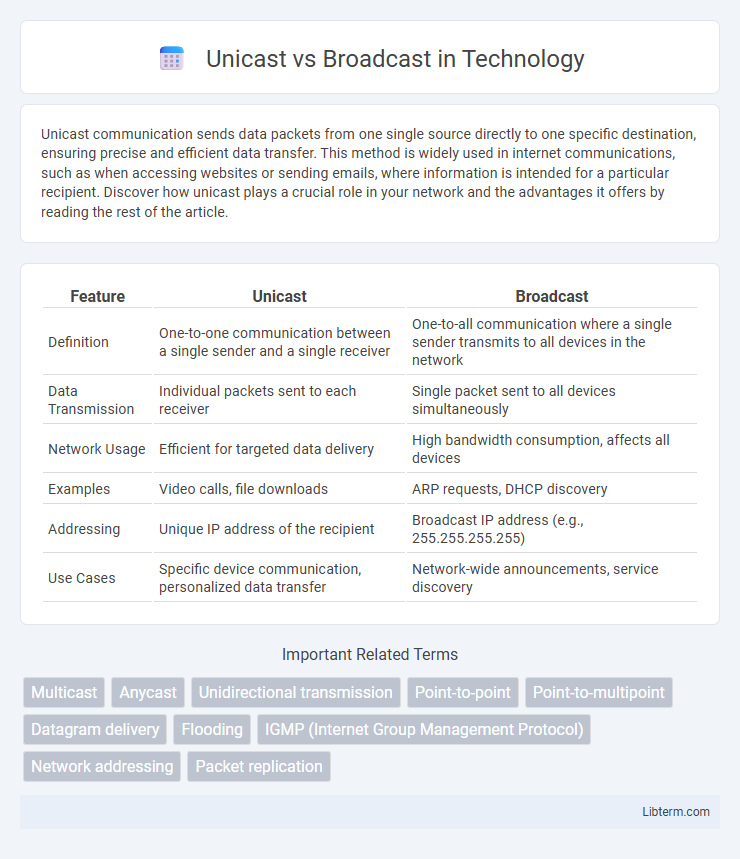Unicast communication sends data packets from one single source directly to one specific destination, ensuring precise and efficient data transfer. This method is widely used in internet communications, such as when accessing websites or sending emails, where information is intended for a particular recipient. Discover how unicast plays a crucial role in your network and the advantages it offers by reading the rest of the article.
Table of Comparison
| Feature | Unicast | Broadcast |
|---|---|---|
| Definition | One-to-one communication between a single sender and a single receiver | One-to-all communication where a single sender transmits to all devices in the network |
| Data Transmission | Individual packets sent to each receiver | Single packet sent to all devices simultaneously |
| Network Usage | Efficient for targeted data delivery | High bandwidth consumption, affects all devices |
| Examples | Video calls, file downloads | ARP requests, DHCP discovery |
| Addressing | Unique IP address of the recipient | Broadcast IP address (e.g., 255.255.255.255) |
| Use Cases | Specific device communication, personalized data transfer | Network-wide announcements, service discovery |
Introduction to Unicast and Broadcast
Unicast is a one-to-one communication method where data is sent from a single sender to a specific receiver, ensuring targeted and efficient data delivery. Broadcast involves one-to-all communication within a network segment, sending data from one sender to all possible receivers simultaneously. These fundamental transmission types define network traffic patterns, affecting bandwidth utilization and network design.
Defining Unicast: One-to-One Communication
Unicast refers to a one-to-one communication method where data packets are sent from a single sender to a single receiver across a network, ensuring direct and exclusive delivery. This communication model is fundamental in applications requiring precise data exchange, such as web browsing, email, and file transfers. Unicast transmission optimizes network resources by targeting specific recipients, minimizing unnecessary data traffic compared to broadcast or multicast methods.
Understanding Broadcast: One-to-All Communication
Broadcast communication transmits data from one sender to all devices within a network segment simultaneously, ensuring message delivery without specifying individual recipients. This one-to-all approach is commonly used in applications like DHCP and ARP, where information must reach every network node. Broadcasts operate at the data link layer using broadcast addresses, enabling efficient dissemination across local area networks (LANs) but potentially causing network congestion if overused.
How Unicast Works in Networking
Unicast in networking involves one-to-one communication where data packets are sent from a single sender to a specific receiver identified by a unique IP address. This method ensures direct delivery, reducing network congestion and improving security by targeting only the intended device. Unicast is commonly used in applications like streaming, online gaming, and web browsing where individualized data transmission is essential.
How Broadcast Works in Networking
Broadcast in networking sends data packets to all devices within a specific network segment simultaneously by using a broadcast address, such as 255.255.255.255 in IPv4. The network interface cards (NICs) on all connected devices listen for this broadcast address and process the packet, ensuring message delivery to every node without needing individual transmissions. This efficient method is commonly used for discovering devices and services, network announcements, and protocols like ARP (Address Resolution Protocol).
Key Differences Between Unicast and Broadcast
Unicast communication involves sending data from a single sender to a specific receiver identified by a unique IP address, ensuring targeted delivery and efficient bandwidth usage. Broadcast sends data from one sender to all devices within a network segment, causing higher bandwidth consumption but useful for network-wide announcements. Key differences include unicast's point-to-point transmission versus broadcast's one-to-all approach, with significant implications for network traffic management and scalability.
Use Cases for Unicast Communication
Unicast communication is ideal for personalized data transmission, such as video calls, online gaming, and private file transfers, where a single sender communicates directly with one receiver. It ensures efficient bandwidth usage by sending data packets exclusively to the intended recipient, reducing network congestion and improving performance. Enterprise applications like remote desktop sessions, VoIP, and email delivery also heavily rely on unicast for secure and reliable point-to-point communication.
Use Cases for Broadcast Communication
Broadcast communication is essential in scenarios where data needs to be simultaneously delivered to multiple recipients, such as network discovery protocols, live streaming, and real-time gaming updates. It optimizes bandwidth by sending a single packet to all nodes in a subnet, making it ideal for ARP requests and DHCP offers in IP networks. Broadcast is also widely used in multimedia distribution and emergency alert systems to ensure rapid, widespread message dissemination.
Security and Efficiency Considerations
Unicast communication enhances security by establishing direct, point-to-point connections that limit data exposure to unintended recipients, reducing the risk of interception and unauthorized access. Broadcast transmits data to all nodes within a network segment, which can cause significant bandwidth consumption and increase vulnerability to eavesdropping and denial-of-service attacks. Efficiency-wise, unicast is more suitable for targeted data delivery, conserving network resources, whereas broadcast can lead to congestion and processing overhead due to indiscriminate data dissemination.
Choosing the Right Method: Unicast or Broadcast
Choosing between unicast and broadcast depends on the network's purpose and audience size. Unicast delivers data directly to a single device, ideal for personalized communication, ensuring efficient bandwidth usage in point-to-point connections. Broadcast sends data to all devices within a network segment, suitable for applications like updates or announcements where broad distribution is required.
Unicast Infographic

 libterm.com
libterm.com